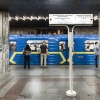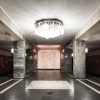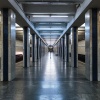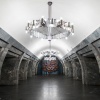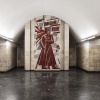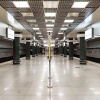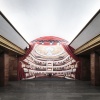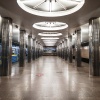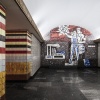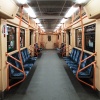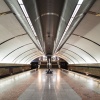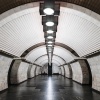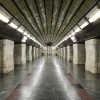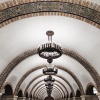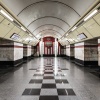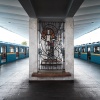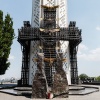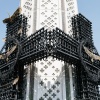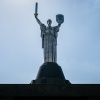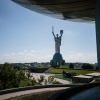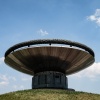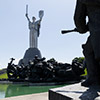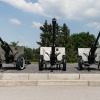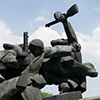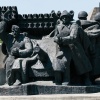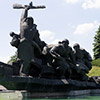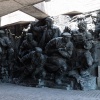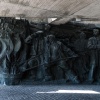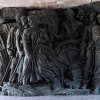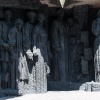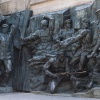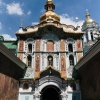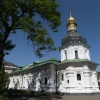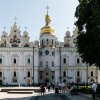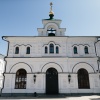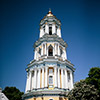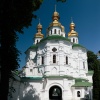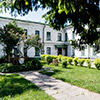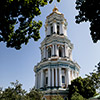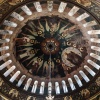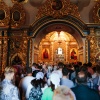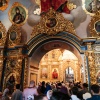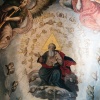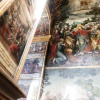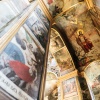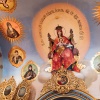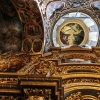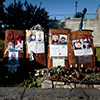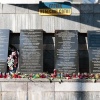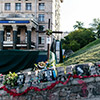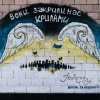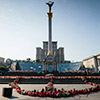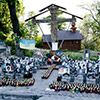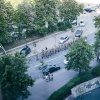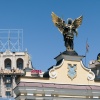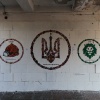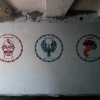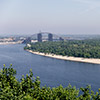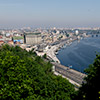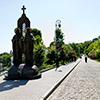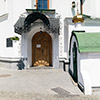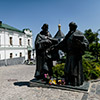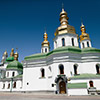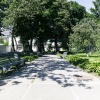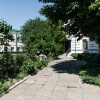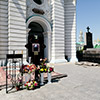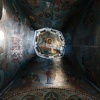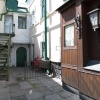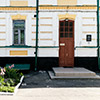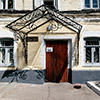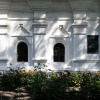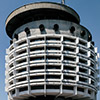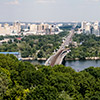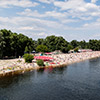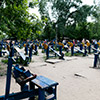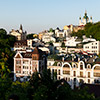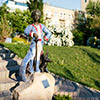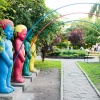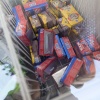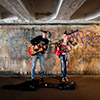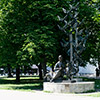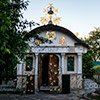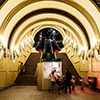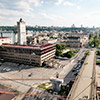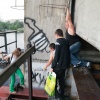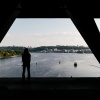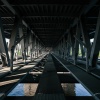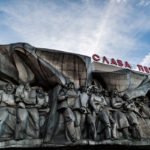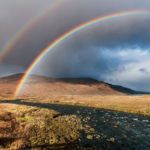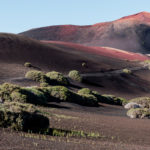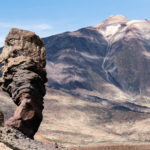Kiev – Monasteries, monuments and Maidan
When it comes to remnants of the Eastern bloc, then Berlin and Kiev are pretty much alike as social as well as architectonical traces are still yet omnipresent in both cities of a 3 million. Kiev’s most remarkable eye catcher is one of the tallest of its kind, that is the imposing Mother Motherland Statue. Where she stands, on the hilltop of the western Dnieper River bank, more recent history meets a reinvigorated orthodoxy as the large Kiev Pechersk Lavra complex with its cave monasteries and wonderfully mystic-melancholic atmosphere is not far away.
Candyfloss and Subway Tunnels
At Berlin-based Kastanienallee (chestnut tree alley) those wonderfully blooming large trees with their palm-sized leafs become less and lesser than the road name might suggest, but Kiev has them in droves. The Ukrainian capital worships that identity-establishing tree with a couple of emblems, for example the metro sign. The Kiev Metro has three lines and they are the actual reason for my visit as they shall be part of my European photo project. They mobilise the city in an impressive 90 second cycle and boast with superlatives like Arsenalna station, that is with 105.5 metres below the surface probably the world’s deepest metro station.
Nowadays Russia once made Ukraine an important gift when building and putting the third subway of former Soviet Union into operation. The Kiev Metro has the same typical classic style all Russian-Soviet undergrounds have and is of course like-wise deeply built in the bowels of the city since all Soviet metro systems are also intended as shelter. Because of that civil defence purpose Kiev Metro staff approaches me instantly and sometimes rude, whereas the “bad” Russians, whose Moscow Metro plays the same shelter role, are relaxed and tolerant regarding my photo project. The Kiev Metro changes as current reconstruction phases remove the Communist heritage from the subway, for example at Teatralna station.
In the very vicinity of the Ukrainian capital, maybe an hour drive away, is Chernobyl, where I have a chance to catch some very personal impressions of the nuclear power plant disaster and Pripyat ghost town. Back in Kiev I can breathe again without a nuclear menace at the back of my neck and may enjoy the city and its streets being staged by blooming trees. The air is full of poplar pollen flying around like thick fluffy snowflakes while pretty as a picture Ukrainian woman proudly stride along the Dnieper riverside promenade in their high heels holding tremendous candyfloss like queens their sceptre.
High above the wide river, on the hilltop of the western riverbank, towers the imposing, sword and shield raising Mother Motherland Statue. That literally jaw-dropping impressive colossal monument easily outdoes New York’s Statue of Liberty and is, like Berlin’s TV Tower, visible from many of Kiev’s places. At its feet a large museum complex invites to get in touch with the biggest event in Soviet history, that is the Great Patriotic War. Besides plenty of original military equipment it boasts with quite a number of typical Communist postmodern style murals and statues.
Right next to Mother Motherland extensive Kiev Pechersk Lavra complex with its cave monasteries invites for a visit. I was coincidentally stopping by at Orthodox Easter time, when religious celebrations are shrouding that place in a mythic but also slightly melancholic atmosphere. Today the reconstructed Cathedral of the Dormition (also Great Pecherskaya Church or Uspensky cathedral) and its Ukrainian Baroque style shine like new. Before the Nazi Germans lay that house of God in ashes back in 1941, the church used to be one of the most important sacred buildings all over Old Russia. In the year 2000 it got completely rebuild and attracts now, in its second life, thousands of pilgrims again to visit a place that was and is dedicated to orthodoxy for more than 1000 years. Most important reason of orthodoxy’s revitalisation is economical difficulties.
Please be careful, as the Orthodox really don’t like it much to become photographed. Also inside the churches it is always better to get permission from the local cleric before getting started. Respect is important, no matter if it’s about humans or religion. Though the Orthodox’ refusal and fastidious supervision when it comes to photography contrasts harshly when remembering how openly and friendly I, as a Muslim-seen disbeliever, got accepted and respected back in Damascus and how I could freely roam around over there. Well, no need to judge Kiev…, as it’s often the same over in my homeland Germany.
The old East-West story
A different yet younger wound is so called Euromaidan, from what countless candles, photos, crosses and soldier parades on Kiev’s central square give evidence. Around the column of Independence Monument photos show the battling Azov Battalion. For some those western backed, supplied and equipped paramilitary fight for Ukraine’s freedom. For others they are simply neo-Nazis, since they publicly display runes and reminiscences to Hitler Germany’s SS. The battalion is also home to anti-Semites, as it has a so called Misanthropic Division that’s frankly speaking about Arian-Ukrainian values.
Blessedly all those things are only extremes and not the normal case. However, in Ukraine’s breast two hearts are beating; one for Europe and the other one for Russia. Both movements get currently exploited by most diverse interests as well as additionally by superior geostrategic desires. Or differently asked, what does the Yankee again in the wrong place?
In fact Ukraine got externally pushed into the mess of a civil war mingling with proxy war. I felt such situations and its outright hostilities in the streets of Kiev when speaking Russian instead of Ukrainian. My ironic “Sorry that I, as a foreigner, am happy to speak at least one major Slavic language to get in touch with you” let most people row back though.
Each country has antis and murmurers, but the range of the anti-Russian resentments is pretty interesting. From my point of view that got injected into the country from the outside. My photographer friend Victor Boyko can tell a thing or two about it as he, as a Russian with Ukrainian roots, was photographer and witness of the Euromaidan. He stood on the protester’s side. They helped each other with food, night watch, hot tea and also emotionally by conversation. But at some point the generally constructive spirit of optimism changed and became simply anti-Russian. Victor, who actively helped by not only writing stupid online bullshit and Facebook posts but by physical presence got severely insulted at Maidan as well as online. Tight friends became real enemies; an experience being pretty painful and incomprehensible, Victor says.
At Maidan, the large square in front of Hotel Ukraina, normal people as well as solider-like men approach me slightly aggressive to donate for the war in the east. Of course I don’t have anything left for wars, no matter who’s fighting who for whatever. My friend Valentyn, who was under artillery fire at Donbass as very young man, comments the overall situation lax but appropriate with “Since ever Ukraine was the battlefield of others; no matter if Germans, Russians, Mongols, Ottomans or – like today – the continuation of West versus East, that is, from my point of view, actually only yet another instalment of rich against poor and their cultures of egoism and solidarity clashing.”
There’s quite some touch to reality in Valentyn’s words; much more reality than in footage and coverage being spread by German heute journal, where the likes of Claus Kleber consciously transfigure the Asov neo-Nazis into rebels and the good. Rich against poor is a conflict that started for Kiev and Ukraine the same way like it did for Berlin, when the Eastern bloc collapsed. Like in Berlin the rent index reflects that conflict excellently, when for a Kiev 70m² apartment being built ind the 1960s already lush and usual 2.000 US$ a month have to be paid while the average income stagnates at around 400€ a month.
Such skyrocketing costs are no single cases and of course there are some people being able to pay all that. The social conflict and contrast couldn’t be harder though and that’s how and why the fate of Berlin and Kiev are pretty similar, when for example in the German capital after the Fall of the Berlin Wall by means of luxury redevelopment long-time residents, Berliner by historic origin and birth, get bailed out. To the saturated western markets of the end 1980’s fortune, the Berlin Wall fell down and Eastern bloc collapsed.
Finally rip off and high profits were possible again, come hell or high water, no matter if in Kiev or Berlin. The Haves mulcted the cherries of properties out of the locals, refurbished the buildings’ appearance and raised rents that drastically to make the rent situation recently becoming an election issue because only newcomers, being the better Berliners due to their bigger wallet, are able to afford living in Berlin’s new city centre. Many, also most media, and even the official “be Berlin” campaign label that process as growth and freedom. You may rate and judge that assessment the way you want, but for me things and people, who and what made this city being great these days, got actively and deliberately damaged. When identity givers get wiped out then one doesn’t have to be surprised when gentrification-driven riots start or expensive cars burn down to the asphalt.
Ukraine still belongs to Europe’s poorest countries. That poverty again is the breeding ground for crime; crime to survive financially in a country where prices skyrocketed within short time, and are still skyrocketing. That’s the background of the large-scale scrap metal thefts in the Chernobyl exclusion zone Leonid was talking about. Also the heavily corruption driven sell-out of Ukrainian arsenal of weapons by the likes of Viktor But has to be seen in the context of crime due to financial survival. The biggest fish in that pond of crime became very influential and powerful people, so called oligarchs.
Pure Petro Presidential Power
One of those oligarchs is Petro Poroshenko, the Chocolate King and current President of Ukraine. He owns the Roshen candy empire ranking #18 among the global top 100 candy companies back in 2013. Only 3 ears later in 2016 it is still globally ranked #22. Not a really significant drop after the main market Russia ceased to exist and Roshen’s revenue got cut by 40% due to a Russia-sided ban on imports. When having a look at official shops such as the ones at the airport and at tourist main spots then one will only see Roshen and no other competitor in the shelves. Petro, the western-backed and hyped perfect democrat, did a good job, didn’t he?
Enough about politics. That dirty swamp, being fed by lies from all sides, blurs the vision for essentials such as interpersonal things. I meet Nasty and Yevgeny, two youngsters living in Kiev’s Podil district. Together we climb two unfinished bridges to enjoy the city view. One of those bridges is the Podilsko-Voskresensky Bridge, a huge steel arch construction with two levels that actually should be in operation already. I join Nastya’s and Yevgeny’s jokes by telling them the dreamy fairy-tale of a new airport in Berlin.
From the bottom of my heart I am wishing Ukraine to find a way to real sovereignty involving a good relation to neighbouring countries. Locking out the Russian ESC participant is mere kids’ stuff and entirely contra productive. A life in real freedom also means not to fall for tricks by the likes of Starbucks, McDonalds and Apple, as they only know and see only maximisation of profits by paying no locals taxes and wiping out cultural peculiarities by all and everything destroying commerce and consumption; a key cognition of my travel vita that’s currently involving 103 countries.

